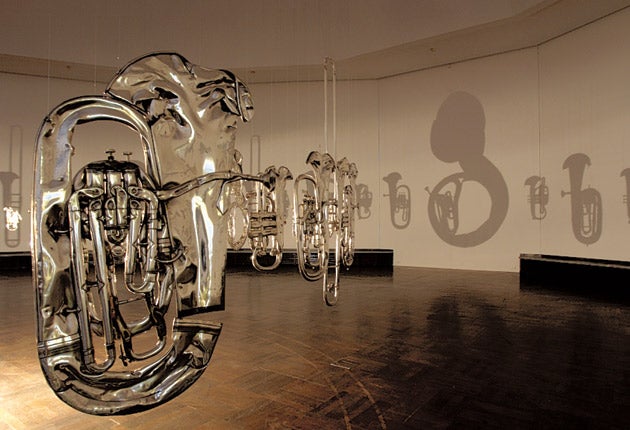Cornelia Parker, Baltic, Gateshead

Your support helps us to tell the story
From reproductive rights to climate change to Big Tech, The Independent is on the ground when the story is developing. Whether it's investigating the financials of Elon Musk's pro-Trump PAC or producing our latest documentary, 'The A Word', which shines a light on the American women fighting for reproductive rights, we know how important it is to parse out the facts from the messaging.
At such a critical moment in US history, we need reporters on the ground. Your donation allows us to keep sending journalists to speak to both sides of the story.
The Independent is trusted by Americans across the entire political spectrum. And unlike many other quality news outlets, we choose not to lock Americans out of our reporting and analysis with paywalls. We believe quality journalism should be available to everyone, paid for by those who can afford it.
Your support makes all the difference.So many things seem airily suspended as you plunge down the steep, twisty streets to the banks of the River Tyne. The Tyne Bridge hangs so high in the air, almost shaving off the rooftops; seagulls wheel above your head, ear-gratingly raucous as a knife blade scraped against a sink. And, over at the old Baltic flour mill on the Gateshead side of the river, the centrepiece of Cornelia Parker's mini-retrospective consists of objects in suspension too. This is not unusual for Parker though. She has often suspended objects in the air. It is almost a trademark sculptural gesture on her part, to draw our attention to the perpetual lightness of things; to transform the nature of what she is inviting us to examine by robbing things of their groundedness, their solidity, their familiar contexts.
The piece itself, a room-size installation that engulfs floor and walls, is called Perpetual Canon. We stand in a huge, square, darkened gallery. The only light comes from a single light bulb suspended at waist height in the middle of a circle of objects that hang suspended by near invisible wires from the ceiling. They cast mighty shadows on all four walls, shadows of wind instruments, 60 of them in all, and when we look at these feignings of the real objects, they look substantial, almost three-dimensional. Then we look back at the objects themselves, hung in that wide, still circle, and we experience a sudden shock, a feeling of revulsion if you like. What we hadn't noticed was that they were not the dignified tubas, trombones, trumpets and French horns that our glimpse at their shadows had led us to believe that they would be. They are horribly crushed and emasculated versions of themselves, spectral presences of the real things, still shining silver by the light of that single bare bulb, but also crushed horribly flat as if they are so much tin foil squeezed in some giant's fist. And here they hang, suspended in the round, as if engaged in some kind of mournful, stately dance. Yes, their shadows look more capable of music-making than these damaged originals. The very haziness of these shadows has helped to smooth away the damage.
When Cornelia Parker is not de-familiarising familiar objects, reducing them to melancholy symbols of themselves, she is causing us to question the nature of the object itself. In the next gallery, an entire series of vitrines and wall pieces show us objects that she has described collectively as "avoided objects". They are objects that seem not quite to be themselves. It is as if they are edging towards objecthood, and then stepping back because they are a mite undeserving of that description. How are we to think of this light projection called Political Abstract, Red and Green, for example? It looks like a bonded pair of intense scribblings. The caption tells us that it consists of fluff gathered from the House of Common and the House of Lords. And yet here it is, elevated, recognised, as if it were worthy of museum recognition. How could stuff so despised have come so far? How does this square with notions of human dignity?
To 19 September (0191 478 1810; Balticmill.com)
Join our commenting forum
Join thought-provoking conversations, follow other Independent readers and see their replies
Comments